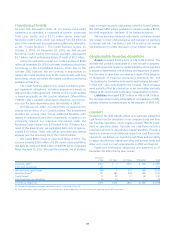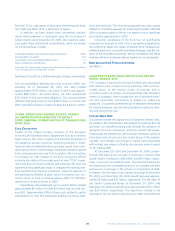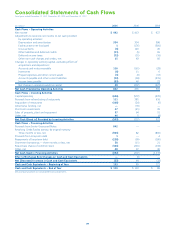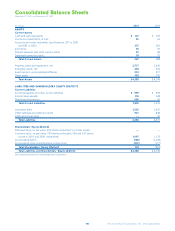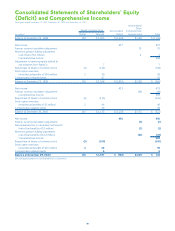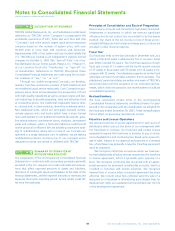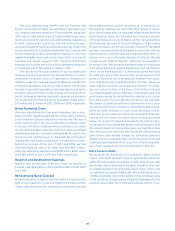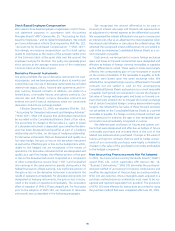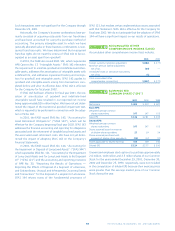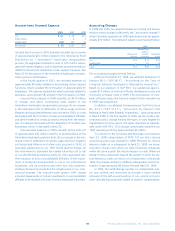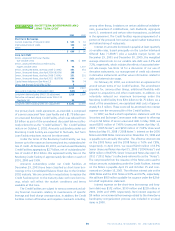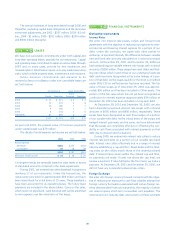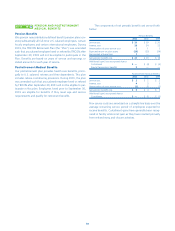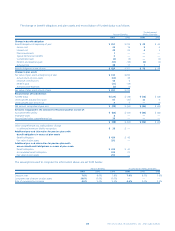Pizza Hut 2001 Annual Report Download - page 47
Download and view the complete annual report
Please find page 47 of the 2001 Pizza Hut annual report below. You can navigate through the pages in the report by either clicking on the pages listed below, or by using the keyword search tool below to find specific information within the annual report.45
Stock-Based Employee Compensation
We measure stock-based employee compensation cost for finan-
cial statement purposes in accordance with Accounting
Principles Board (“APB”) Opinion No. 25, “Accounting for Stock
Issued to Employees,” and its related interpretations. We include
pro forma information in Note 16 as required by SFAS No. 123,
“Accounting for Stock-Based Compensation” (“SFAS 123”).
Accordingly, we measure compensation cost for stock option
grants to employees as the excess of the average market price
of the Common Stock at the grant date over the amount the
employee must pay for the stock. Our policy is to generally grant
stock options at the average market price of the underlying
Common Stock at the date of grant.
Derivative Financial Instruments
Our policy prohibits the use of derivative instruments for trad-
ing purposes, and we have procedures in place to monitor and
control their use. Our use of derivative instruments has included
interest rate swaps, collars, forward rate agreements and for-
eign currency forward contracts. In addition, we utilize on a
limited basis, commodity futures and options contracts. Our
interest rate and foreign currency derivative contracts are
entered into with financial institutions while our commodity
derivative contracts are exchange traded.
Effective December 31, 2000, we adopted SFAS No. 133,
“Accounting for Derivative Instruments and Hedging Activities”
(“SFAS 133”). SFAS 133 requires that all derivative instruments
be recorded on the Consolidated Balance Sheet at fair value.
The accounting for changes in the fair value (i.e., gains or losses)
of a derivative instrument is dependent upon whether the deriv-
ative has been designated and qualifies as part of a hedging
relationship and further, on the type of hedging relationship.
For derivative instruments that are designated and qualify as a
fair value hedge, the gain or loss on the derivative instrument
as well as the offsetting gain or loss on the hedged item attrib-
utable to the hedged risk are recognized in the results of
operations. For derivative instruments that are designated and
qualify as a cash flow hedge, the effective portion of the gain
or loss on the derivative instrument is reported as a component
of other comprehensive income (loss) (“OCI”) and reclassified
into earnings in the same period or periods during which the
hedged transaction affects earnings. Any ineffective portion of
the gain or loss on the derivative instrument is recorded in the
results of operations immediately. For derivative instruments not
designated as hedging instruments, the gain or loss is recog-
nized in the results of operations immediately. The cumulative
effect of adoption of SFAS 133 was insignificant. For fiscal years
prior to the adoption of SFAS 133, our treatment of derivative
instruments was as described in the following paragraphs.
We recognized the interest differential to be paid or
received on interest rate swap and forward rate agreements as
an adjustment to interest expense as the differential occurred.
We recognized the interest differential to be paid or received on
an interest rate collar as an adjustment to interest expense when
the interest rate fell below or rose above the collared range. We
reflected the recognized interest differential not yet settled in
cash in the accompanying Consolidated Balance Sheets as a cur-
rent receivable or payable.
Each period, we recognized in income foreign exchange
gains and losses on forward contracts that were designated and
effective as hedges of foreign currency receivables or payables
as the differential occurred. These gains or losses were largely
offset by the corresponding gain or loss recognized in income
on the currency translation of the receivable or payable, as both
amounts were based upon the same exchange rates. We
reflected the recognized foreign currency differential for forward
contracts not yet settled in cash on the accompanying
Consolidated Balance Sheets each period as a current receivable
or payable. Each period, we recognized in income the change in
fair value of foreign exchange gains and losses on forward con-
tracts that were entered into to mitigate the foreign exchange
risk of certain forecasted foreign currency denominated royalty
receipts. We reflected the fair value of these forward contracts
not yet settled on the Consolidated Balance Sheets as a current
receivable or payable. If a foreign currency forward contract was
terminated prior to maturity, the gain or loss recognized upon
termination was immediately recognized in income.
We deferred gains and losses on futures and options con-
tracts that were designated and effective as hedges of future
commodity purchases and included them in the cost of the
related raw materials when purchased. Changes in the value of
futures and options contracts that we used to hedge compo-
nents of our commodity purchases were highly correlated to
changes in the value of the purchased commodity attributable
to the hedged component.
New Accounting Pronouncements Not Yet Adopted
In 2001, the Financial Accounting Standards Board (“FASB”)
issued SFAS 141, which supersedes APB Opinion No. 16,
“Business Combinations.” SFAS 141 eliminates the pooling-of-
interests method of accounting for business combinations and
modifies the application of the purchase accounting method.
SFAS 141 also specifies criteria intangible assets acquired in a
purchase method business combination must meet to be rec-
ognized and reported separately from goodwill. The provisions
of SFAS 141 were effective for transactions accounted for using
the purchase method that were completed after June 30, 2001.


